What are business process templates? Definition, types and benefits
Written by Andrea
7 September 2023 · 8 min read
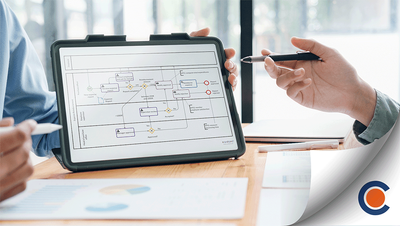
Nowadays, organizations continuously look for new ways to optimize their workflows and streamline operations to stay competitive and deliver exceptional results. That’s where business process templates can come into play. They eliminate the need to perform the same manual tasks repeatedly, provide a consistent and standardized approach to working with processes, and empower teams to navigate complex workflows easily.
In this blog post, we look into the concept of business process templates, explore their significance, typology, and benefits, and how they serve as the foundation for better process management.
Business process templates definition
A business process template is a type of document that describes some aspect of a process, such as process flow, landscape, or state. It contains predefined rules, guidelines, or workflows that help organizations standardize and streamline their business processes, reducing redundancy and costs, minimizing errors, and improving overall productivity.
Oftentimes, process templates include the following elements:
- specific activities and tasks organized in a logical sequence that need to be performed to achieve a particular objective;
- roles and responsibilities that clarify who is responsible for what;
- a sequence of steps required to complete a process which includes the order of activities, dependencies between tasks, and conditions for moving from one stage to another;
- guidelines, best practices, and quality standards to ensure work is performed consistently and to the expected quality;
- estimated timeframes and deadlines to keep the project on track;
- tools, software, and resources necessary to perform various tasks efficiently;
- requirements for documenting progress and generating reports.
Business process templates are based on a specific view with particular stakeholder concerns and are built to support a particular need or want. By using process templates, teams involved in Business Process Management can:
- enable process identification, creation, and realization in achieving specific needs and wants;
- pinpoint all relevant stakeholders and their roles, requirements, and concerns;
- identify process descriptions, their semantic rationale, and the corresponding tasks to the specific views and viewpoints.
These templates often find application in project management, software development, quality assurance, and other business domains and help ensure consistency and efficiency in the execution of tasks. They can be customized to suit the specific needs of each project or business process while maintaining a consistent and structured approach to work.
Types of business process templates
There are three types of business process templates - process maps, process matrices, and process models. Each type describes the semantic relations of the various process objects and their application within different contexts.
Process map
A process map contains an accurate list of sets of decomposed and/or composed process objects. Its primary purpose is to provide a list of all business processes in the organization. The list helps understand the functionality of each process and provides a centralized overview and record of all the key processes.
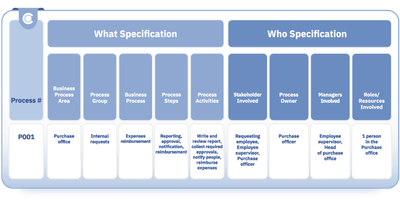
An example of a process map
By using a process map, teams can:
- identify relevant processes, including the name of the process;
- specify a unique process identifying number;
- specify the level of process detail, that is process area, process group, process, steps, or activities;
- connect the involved business units and stakeholders to the relevant process;
- list the process owners and anyone else involved, such as a process approver and process checker.
Process matrix
A process matrix shows the relationship between two sets of decomposed process objects that semantically have primary and direct natural relations to one another. Visually, the relationship is illustrated in the form of two lists, with rows and columns, in which process objects from one layer are connected to process objects from the same or a different layer.
The table below presents a process matrix that illustrates the columns of the process map combined with performance indicators. By using this template, teams can ensure that the content of each column has a minimum of one process indicator.
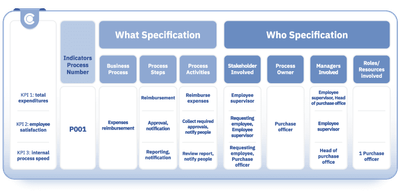
An example of a process matrix
Some of the main reasons for creating a process matrix include:
- linking business processes to organizational goals;
- creating value-oriented process connections;
- understanding the end-to-end business process flow;
- identifying business process problems to fix a defective or inefficient process;
- specifying the business, information, or data objects involved in the process;
- connecting performance indicators to business processes;
- reducing process costs;
- identifying and relating compliance aspects;
- implementing process automation.
The above-stated reasons determine the design and content of the process matrix and how the process matrix should look.
Process model
Once enough information is collected and organized in process maps and/or process matrices, teams can create a process model. The latter provides a high-level representation of a business process or system. It helps understand and communicate the overall structure and flow of a process and illustrate the major components, interactions, and dependencies between various elements.
By using business process models, teams can:
- use the complex set of resulting process information in different disciplines;
- work and model with process objects throughout all aspects of the organization - business, application, and technology;
- ensure completeness and alignment of the process information;
- easily communicate the information to stakeholders.
Process objects and process modeling rules govern the semantic relations of process models. The process modeling rules ensure how and where the process templates interlink and share common process objects. The figure below illustrates a business process model that includes processes, roles, interactions, and other elements.
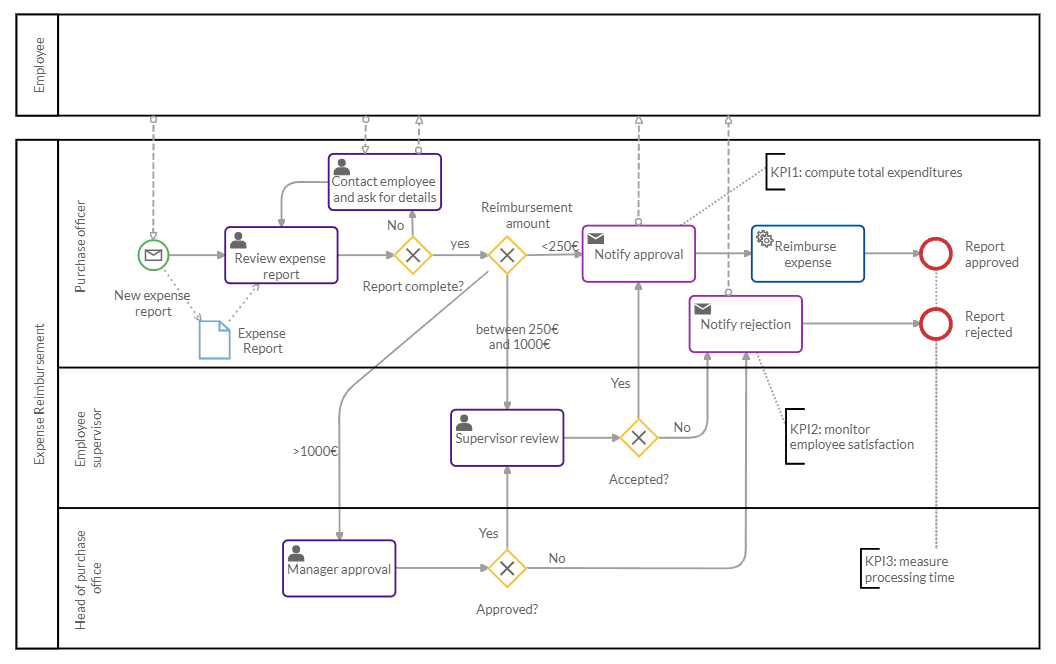
A template of an expense reimbursement process model available in the Cardanit editor
Some common types of business process models include:
- Flowcharts - these models use standardized symbols - for example, BPMN 2.0 - to represent the sequential flow of various activities, interactions, and decision points in a business process.
- Data Flow Diagrams (DFD) - these diagrams illustrate the flow of data within a business system or process.
- UML (Unified Modeling Language) activity diagrams - this type of process models illustrates the flow of activities and actions in a system or process, including branching and concurrent activities.
- IDEF (Integrated Definition) diagrams - these diagrams utilize modeling techniques for capturing and representing business processes, data models, and other types of systems.
Selecting the right modeling language for creating process models depends on various factors, including the specific needs and context of the organization. In this regard, the use of BPMN is often recommended over other modeling languages, such as UML or IDEF, because it has a wider application and provides a rich set of symbols and notations. On top of that, BPMN integrates with other standards such as DMN, supports process modeling for both business and technical users, and can be easily understood by all stakeholders.
Finally, process models often find application in business process analysis, improvement, and documentation. They serve as a foundation for understanding the process and can be further detailed into more specific diagrams as needed.
Benefits of using process templates
Process templates offer several benefits, especially in the context of business process management and workflow standardization. For instance, process templates:
- provide a consistent and standardized approach to working with project artifacts and documenting and executing processes;
- are easily customizable according to specific project needs;
- increase employee(s) productivity;
- help save time and effort in process design and implementation;
- can incorporate best practices, quality standards, and regulatory requirements to ensure that processes are designed and executed in a compliant and quality-focused manner;
- lift the project artifacts to levels 3 and 4 according to the Capability Maturity Model (CMM);
- simplify process updates and changes;
- enable better process analysis and performance measurement;
- help identify business process problems, inefficiencies, and areas for improvement;
- help ensure effective communication and collaboration among team members;
- serve as valuable documentation for auditing purposes;
- are fully integrated into the BPM lifecycle, BPM governance, and BPM change management.
Overall, business process templates offer a structured and organized approach to process management and support businesses in achieving consistency, efficiency, and continuous improvement in their operations.
Paper versus digital business process templates

Using digital process templates instead of paper-based ones offers numerous advantages that can significantly improve efficiency, collaboration, and overall process management. Here are some key reasons why teams should use digital business process templates:
- Easily accessed from anywhere, anytime
Digital templates can be accessed from anywhere with an internet connection, making them available to teams and employees working remotely. On the other hand, paper-based templates are limited to physical copies and may not be easily accessible to all team members.
- Automated and visual reporting
When using a BPM tool like Cardanit, process templates can be easily transformed into visual reports, providing a clear view of the entire process. These reports may include detailed workflow descriptions, screenshots, links, and element explanations.
- Help ensure seamless collaboration and version control
Digital process templates allow for real-time updates and version control, while paper-based templates require manual updates and may lead to discrepancies between different copies. By using digital templates, all users can immediately access the latest version and collaborate simultaneously on a single document. They can easily gather input and feedback and track and document all changes.
- Easy to customize and adapt to any project needs
Unlike paper-based process templates, which are difficult to format, digital templates are easily customizable, especially when edited with modeling tools like Cardanit. Process modeling tools often provide users with a drag-and-drop functionality, features for rearranging and resizing elements, and the possibility to change the font, color, and style of various elements to match the branding of the organization.
- No data loss due to unforeseen events
When in a digital format, business process templates can be backed up regularly, ensuring data safety and facilitating quick recovery in case of data loss due to unforeseen events.
In summary, digital process templates offer greater flexibility, accessibility, collaboration, and efficiency than paper-based ones. They can liberate teams from repetitive, time-consuming tasks, empowering them to focus on creativity and innovation.
Cardanit process templates library
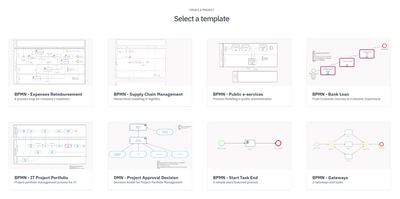
Cardanit provides many tools and features to model and optimize business processes. It allows users to design process models using the BPMN 2.0 and DMN 1.3 standards.
Cardanit also offers users a template library with a good selection of pre-designed process model templates that cater to various industries, use cases, and common process patterns - for example:
- Public administration - templates for modeling public e-services,
- Banking - templates for modeling bank loan application processes, from customer journey to customer experience.
- Information Technology - templates for modeling project portfolio management processes,
- Logistics - templates for hierarchical modeling of supply chain management processes.
Users can utilize the library as a starting point for creating their own simple or more complex business process models. They can also easily customize the templates to adapt them to their specific business requirements and add or modify process steps as needed.
In conclusion
Business process templates help companies transform their operations from disjointed and specific to systematic and streamlined. They provide the much-needed structure and clarity, guiding teams through complex processes with ease. As a result, organizations can drive better decision-making, mitigate errors, and enhance overall performance.
Moreover, the benefits of business process templates extend beyond time-saving and cost-efficiency. They foster effective communication and collaboration among teams working together on process-related projects. Their successful implementation in organizations also promotes a culture that values process optimization and continuous improvement.
Finally, to harness the full potential of business process templates, investing in digital modeling tools like Cardanit is essential to streamline the process mapping and optimization journey.
Further reading
Cloud-based BPM: Collaborative process modeling in the era of remote work
IT white paper: Streamlining IT business processes with BPMN


Andrea is the collective pseudonym for the group of people working behind Cardanit, the Business Process Management Software as a Service of ESTECO. The group has different backgrounds and several decades of experience in fields varying from BPM, BPMN, DMN, Process Mining, Simulation, Optimization, Numerical Methods, Research and Development, and Marketing.
Andrea is the collective pseudonym for the group of people working behind Cardanit, the Business Process Management Software as a Service of ESTECO. The group has different backgrounds and several decades of experience in fields varying from BPM, BPMN, DMN, Process Mining, Simulation, Optimization, Numerical Methods, Research and Development, and Marketing.
Learn how to effectively represent data in your BPMN diagrams, create reliable data models and design processes that align with your organizational goals.
Do you know how to model data in BPMN?
Learn how to effectively represent data in your BPMN diagrams, create reliable data models and design processes that align with your organizational goals.
Do you know how to model data in BPMN?
Learn how to effectively represent data in your BPMN diagrams, create reliable data models and design processes that align with your organizational goals.
